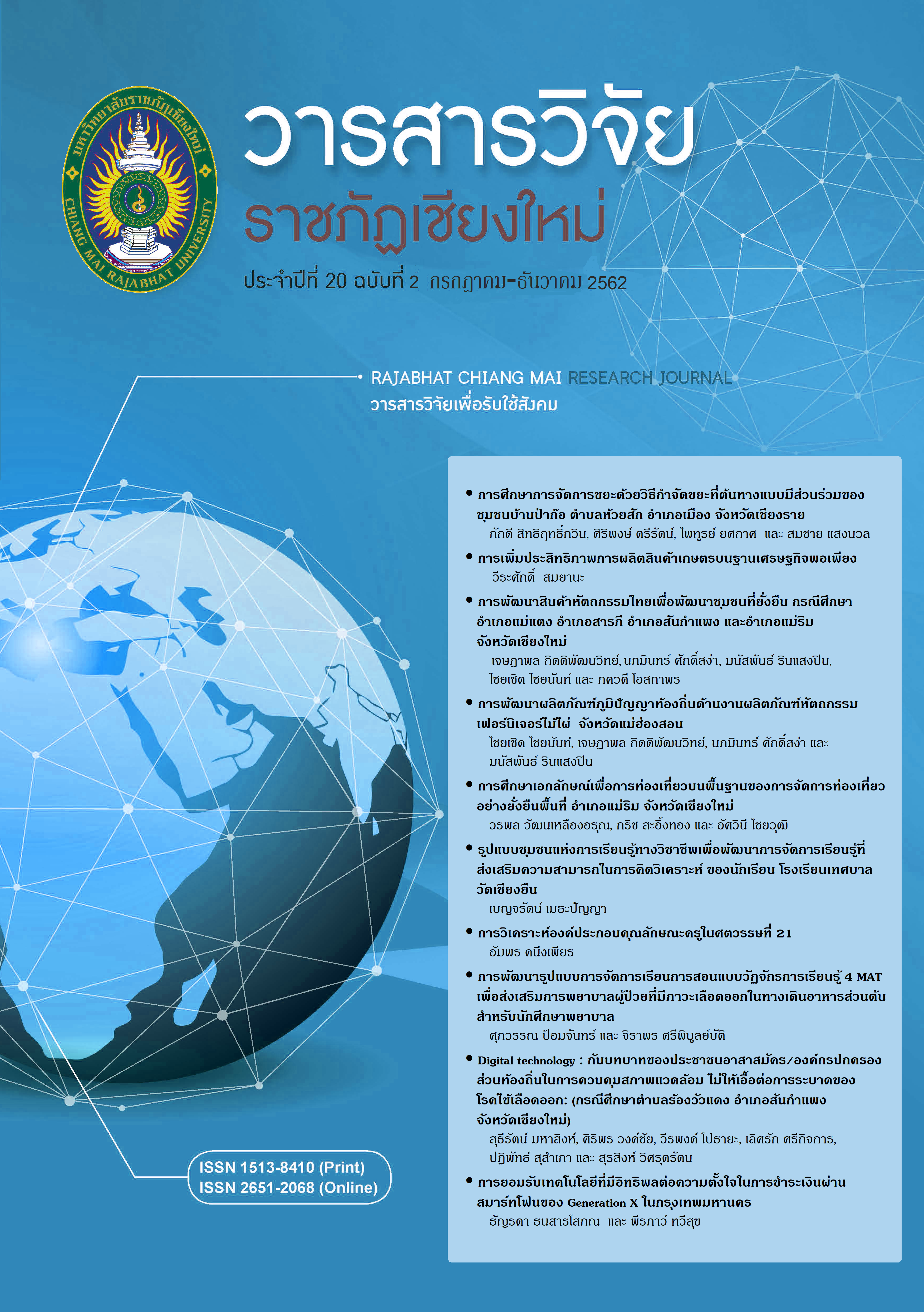การพัฒนารูปแบบการจัดการเรียนการสอนแบบวัฏจักรการเรียนรู้ 4 MAT เพื่อส่งเสริมการพยาบาลผู้ป่วยที่มีภาวะเลือดออกในทางเดินอาหารส่วนต้น สำหรับนักศึกษาพยาบาล
DOI:
https://doi.org/10.14456/rcmrj.2019.218157คำสำคัญ:
การเรียนการสอนแบบวัฏจักรการเรียนรู้ 4 MAT, ภาวะเลือดออกในทางเดินอาหารส่วนต้น, นักศึกษาพยาบาลบทคัดย่อ
การวิจัยนี้ มีวัตถุประสงค์ เพื่อพัฒนารูปแบบการเรียนการสอนแบบวัฏจักรการเรียนรู้ 4 MAT และ วัดผลสัมฤทธิ์ของการจัดการเรียนการสอนแบบวัฏจักรการเรียนรู้ 4 MAT โดยเปรียบเทียบผลสัมฤทธิ์ทางการเรียน เรื่อง การพยาบาลผู้ป่วยที่มีภาวะเลือดออกในทางเดินอาหารส่วนต้น สำหรับนักศึกษาพยาบาล ศึกษาวิจัยใช้รูปแบบการวิจัยและพัฒนา (Research and development: R & D) ซึ่งมีรายละเอียดวิธีดำเนินการวิจัย แบ่งเป็น 4 ขั้นตอน ดังนี้ คือ การศึกษาสภาพการเรียนการสอน การออกแบบและพัฒนารูปแบบการเรียนการสอน การทดลองใช้ และการประเมินผลและการปรับปรุงรูปแบบ กลุ่มตัวอย่างเป็นอาจารย์พยาบาลที่สอนในรายวิชารายวิชาการพยาบาลบุคคลที่มีปัญหาสุขภาพ 1 จำนวน 5 คน และนักศึกษาพยาบาลศาสตรบัณฑิตชั้นปีที่ 2 วิทยาลัยพยาบาลบรมราชชนนีสวรรค์ประชารักษ์ นครสวรรค์ จำนวน 30 คน เครื่องมือที่ใช้ในการศึกษาประกอบด้วย แบบสอบถาม แบบสัมภาษณ์ รูปแบบการเรียนการสอนแบบวัฏจักรการเรียนรู้ 4 MAT และแบบทดสอบวัดผลสัมฤทธิ์การพยาบาลผู้ป่วยที่มีภาวะเลือดออกในทางเดินอาหารส่วนต้น ได้รับการตรวจสอบเชิงเนื้อหามีค่าความเชื่อมั่น .85 วิเคราะห์ข้อมูลด้วยค่าร้อยละ ค่าเฉลี่ย ส่วนเบี่ยงเบนมาตรฐาน และสถิติค่าที
ผลการวิจัย พบว่า ปัญหาการจัดการเรียนสอน ด้านอาจารย์ ส่วนใหญ่มีวิธีการสอนแบบบรรยาย ด้านนักศึกษา พบว่า การสอนแบบบรรยาย ทำให้นักศึกษาไม่เห็นภาพในการปฏิบัติการพยาบาลผู้ป่วยที่มีภาวะเลือดออกในทางเดินอาหารส่วนต้น และผลการใช้รูปแบบการสอน พบว่า กลุ่มตัวอย่างมีคะแนนผลสัมฤทธิ์ทางการเรียน เรื่อง การพยาบาลผู้ป่วยที่มีภาวะเลือดออกในทางเดินอาหารส่วนต้น สำหรับนักศึกษาพยาบาลหลังเรียนสูงกว่าก่อนเรียนอย่างมีนัยสำคัญทางสถิติที่ระดับ .01
Downloads
เอกสารอ้างอิง
ม.ป.ท.: ม.ป.พ. (เอกสารอัดสำเนา).
นูรมา อาลี. (2559). ผลการจัดการเรียนรู้แบบ 4 MAT ที่มีต่อผลสัมฤทธิ์ทางการเรียน ความคงทนในการเรียนรู้ และความพึงพอใจต่อการจัดการเรียนรู้ของนักเรียนชั้นมัธยมศึกษาปีที่ 6. วิทยานิพนธ์ปริญญาศึกษาศาสตรมหาบัณฑิต สาขาวิชาการสอนวิทยาศาสตร์และคณิตศาสตร์ มหาวิทยาลัยสงขลานครินทร์.
บุษยารัตน์ ลอยศักดิ์. (2558). ปัจจัยที่มีความสัมพันธ์กับพฤติกรรมสุขภาพของผู้ป่วยที่มีภาวะเลือดออกในทางเดินอาหารส่วนต้นซ้ำ. วิทยานิพนธ์พยาบาลศาสตรมหาบัณฑิต มหาวิทยาลัยบูรพา.
พระราชบัญญัติการศึกษา (2562). หมวด 2 หลักการของการจัดการอุดมศึกษา ส่วนที่ 2 หลักความรับผิดชอบ.สืบค้นจาก
https://www.ratchakitcha.soc.go.th/DATA/PDF/2562/A/057/T_0054.pdf
วิจารณ์ พานิช. (2555). วิถีสร้างการเรียนรู้เพื่อศิษย์ในศตวรรษที่ 21.กรุงเทพฯ : มูลนิธิสดศรี-สฤษดิ์วงศ์.
ศิริพันธุ์ ศิริพันธุ์, วิชัย วงศ์สุวรรณ และอัญญรัตน์ นาเมือง. (2557). วิธีสอนแบบบรรยายร่วมกับเทคนิคกราฟิก และสารสนเทศร่วมสมัย เพื่อพัฒนาผลสัมฤทธิ์ทางการเรียน. Princess of Naradhiwas University Journal Humanities and social science, 1(1), 12-20.
สถาบันพระบรมราชชนก. (2562). วิสัยทัศน์ อำนาจ หน้าที่และพันธกิจ. สืบค้นจาก https://www.pi.ac.th/group
สมชาย เหลืองจารุ. (2553). Endoscopic Finding of Upper GI Bleeding in lower Northeast part of Thailand. ใน : สมบัติ ตรีประเสริฐสุข, พิสิฐ ตั้งกิจวานิชย์ และวโรชา มหาชัย, บรรณาธิการ Emerging Diagnostic and Therapeutic Strategies in Gastroenterology and Hepatology. กรุงเทพฯ: บริษัทสร้างสื่อจำกัด.
สุวรรณี แสงอาทิตย์, ธัญพร ชื่นกลิ่น และชุติมา เทียนชัยทัศน. (2559). ผลการสอนแบบ 4 MAT ต่อความสามารถในการคิดวิเคราะห์ของนักศึกษา พยาบาลศาสตรบัณฑิต ชั้นปี ที่ 3 วิทยาลัยพยาบาลพระจอมเกล้าจังหวัดเพชรบุรี.วารสารวิจัยทางวิทยาศาสตร์สุขภาพ, 10(2), 82-91.
แสงสุรีย์ ดวงคำน้อย. (2561). การเรียนรู้เชิงรุก : กิจกรรมท้าทายสำหรับผู้เรียนในยุคการศึกษา 4.0. วารสารวิชาการและวิจัย มหาวิทยาลัยภาคตะวันออกเฉียงเหนือ, 8 (3), 61-71.
อังคณา ศรีสัมฤทธิ์, สมคิด ปานประเสริฐ และอินทิรา พันธุ์เมธิศร์. (2557). การพัฒนาระบบการดูแลผู้ป่วยภาวะเลือดออกในทางเดินอาหารส่วนต้น. วารสารกองการพยาบาล, 41(1), 36-55.
McCarthy, Bernice. (1990). Using the 4 MAT System to Bring Learning Styles to School Eric Accession: NISC Discover Report. 31-37, October.
Partnership for 21 Century Learning. (2009). Framework for 21st century learning. Retrieved from https://www.p21.org/storage/documents/docs/P21_Framework_Definitions_NewLogo_2015.pdf
ดาวน์โหลด
เผยแพร่แล้ว
รูปแบบการอ้างอิง
ฉบับ
ประเภทบทความ
สัญญาอนุญาต
1. บทความ ข้อมูล เนื้อหา รูปภาพ ฯลฯ ที่ได้รับการตีพิมพ์ใน “Community and Social Development Journal” ถือเป็นลิขสิทธิ์ของ Community and Social Development Journal มหาวิทยาลัยราชภัฏเชียงใหม่ และเพื่อให้เผยแพร่บทความได้อย่างเหมาะสมผ่านสื่อสิ่งพิมพ์และอิเล็กทรอนิกส์ ผู้เขียนยังคงถือครองลิขสิทธิ์บทความที่ตีพิมพ์ภายใต้ใบอนุญาต Creative Commons Attribution (CC BY) ซึ่งอนุญาตให้เผยแพร่บทความซ้ำในแหล่งอื่นได้ โดยอ้างอิงต้องอ้งอิงบทความในวารสาร ผู้เขียนต้องรับผิดชอบในการขออนุญาตผลิตซ้ำเนื้อหาที่มีลิขสิทธิ์จากแหล่งอื่น
2. เนื้อหาบทความที่ปรากฏในวารสารเป็นความรับผิดชอบของผู้เขียนบทความโดยตรง ซึ่งกองบรรณาธิการวารสารไม่จำเป็นต้องเห็นด้วยหรือร่วมรับผิดชอบใดๆ














